Almost two years ago I reviewed the Smith & Wesson M&P45 Shield and came away impressed by the little .45 auto concealed carry pistol. Smith also offers a tricked out version of the same gun from their Performance Center, with a few extras. Some of those extras are welcome additions to an already great EDC pistol. Others…not so much.

In general, if you liked the original Shield — and man I did — you’ll like the Performance Center version, too. The PC Shield has all of the same basic characteristics. It’s small enough to carry easily in almost any conditions. It’s surprisingly accurate for its size, and it handles the recoil of the .45 ACP round phenomenally well for a pistol that weighs less than a pound and a half.
When it come to testing the reliability and accuracy of the Performance Center Shield, this was was little more than a quality control exercise. This gun scored the same.
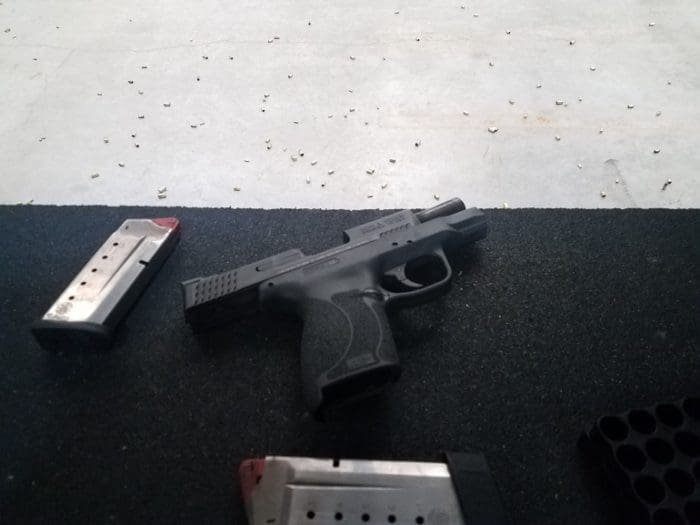
Out of the 500 rounds I shot, using several different types of ammunition, I never had a single failure to feed, fire, or eject. I fed it .45ACP loads from 185gr HPs to 230gr HPs and round nosed FMJs. The magazine never failed to seat properly and it never failed to drop fully when the magazine released was pressed.
It should be noted that the Trial and Evaluation gun I got from Smith was well used and absolutely filthy. But that’s a good thing. I have a general policy that if a company sends me a dirty gun for review, a dirty gun gets reviewed.
I lubed the gun prior to firing with EEZox, and never did any more maintenance or lubrication of the gun again throughout the process. Result: perfect reliability.
Just like the original, the Performance Center M&P45 scored numerous three-inch groups at 25 yards off a rest with several types of ammunition. Really, the measurements were were virtually identical. Good job on the QC, S&W.

I was also once again impressed with the grip of the pistol. Much like the last time I reviewed the Shield, I was once again in 100 degree weather on the range. Still, the tiny .45ACP locked down into my sweaty palms with very little movement between shots. This is the best stock grip I’ve fired in such as small gun.
The other details are also the same. Same quality but generally unattractive finish. Same ease of takedown and cleaning. You don’t have to pull the trigger to take the gun apart if you go to the trouble of using the patented M&P Takedown Lever and Sear Deactivation Lever. Or you can just clear the gun and pull the trigger (while pointed in a safe direction, of course) for a fast, easy, and safe disassembly.
There are a few things different on the Performance Center model, and most of them are welcome additions.

The Smith & Wesson website lists the Performance Center version as having an “enhanced trigger,” but it feels the same to me. The trigger is good enough, but this gun’s two-piece hinged design gave me the same problem as did the original.
Namely, the natural place for me to put my finger was above the hinge line, so no matter how hard I pulled the trigger the gun wouldn’t fire. It wasn’t until I allowed my finger to move down the trigger, more like with a double action revolver’s trigger, that it broke. If this was my daily carry, I’d certainly be able to train myself out of that.
Unlike the last Shield I reviewed, this Performance Center version doesn’t come with a safety. I generally like a safety on my EDC guns, but I don’t find them necessary at all. As long as they’re carried in a well-fitting, quality holster and that holster can be visually inspected every single time the gun is put in it, they are completely safe.
One of the things I noted in my review of the standard M&P Shield back in 2016 was that there was no option for night sights offered for the .45ACP at that time. That option existed for other calibers, just not the .45 ACP. That omission has since been rectified, and the Performance Center edition of the .45 ACP Shield includes the tritium night sights as a standard part of the package.
As an added benefit, these sights include a drift adjustable rear sight with a ledge suitable for single-handed racking on a belt, pocket, boot, or other hard surface.
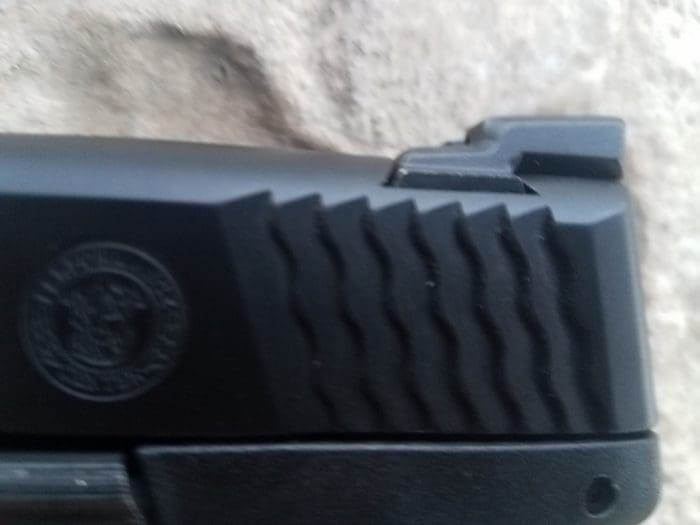
I consider high visibility sights to be of absolute importance in an everyday carry concealed carry pistol. Tritium is my gold standard, but I’ve found bright fiber optic front sights also do well in dim light conditions. I have heard people say that “night sights” are of no value, because if you can’t see your sights, you can’t see your target anyway.
That’s just not the case. First, there are environmental realities, like the fact that your target might be illuminated more than your sights. That’s especially true if your target is illuminated by a flashlight.
The more obvious factor is that your target in a self defense situation is, in almost every conceivable scenario, significantly larger than your sights. But just because your attacker is big enough to identify, that attacker may not be big enough to hit while you search for your tiny dark front sight. At least not in time to save your life.

I have fought in the dark without the use of night vision devices with the Afghan Police Force and Afghan National Army. The only takeaway I have from that experience is that it really sucks to not be able to see when everyone is shooting around you (and at you).
The translatable experience I have on the topic is pig hunting. I do most of my pig hunting at night, and occasionally just with a pistol. I run a hand-held light, but also a frame-mounted light on the gun itself. The hand-held is for locating the pigs, the frame mounted is for when I sneak up close enough to actually start shooting.
There’s not but a second or two when that pistol mounted light comes on and the pigs start running. The tritium sights work the best, but the backwash of the light is usually enough if I’m just running good fiber optic sights as well. I’ve tried it many times and there’s just no hope of getting on the pigs fast enough when I’m also searching for them using dim sights.
It’s called a “shot in the dark” for good reason.
Unfortunately, some of the advantage of those night sights is negated by the inclusion of a ported barrel on the Performance Center Shield. A ported barrel is, in its simplest form, holes cut in the barrel and slide for the purpose of reducing muzzle rise and felt recoil by the shooter.
There is no doubt that ported barrels reduce recoil. How much they reduce recoil varies greatly on the gun, the cartridge, the length of the barrel, the number and shape of the ports, and at least as much as any of those, the type of ammunition used.
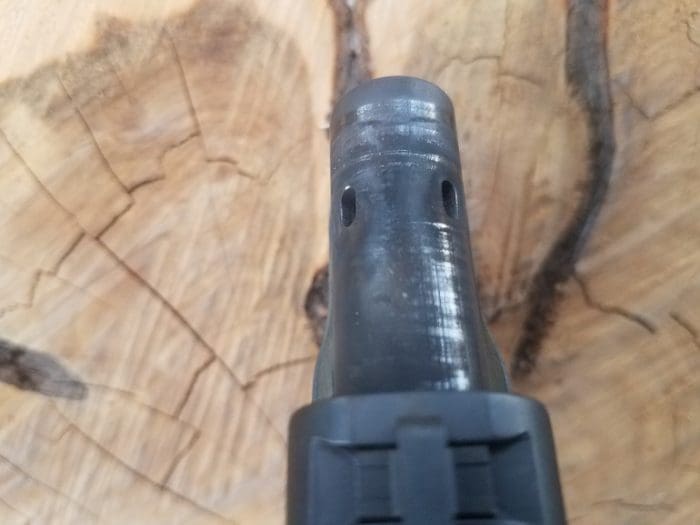
First, it’s important to understand that a ported barrel lowers muzzle velocity. Usually by only a little, but sometimes by quite a bit. From a short-barreled .45ACP pistol like this one, you can expect muzzle velocities to be reduced by about 5%.
Again, some ammunition will be a little more, and some “low flash” ammunition may be a little less. Sure that’s not much, but it’s something. And it’s especially something on a short-barreled .45ACP, where you’ve already lost some speed — about 100fps — compared to a five-inch barrel.
The way ports reduce recoil is by directing explosive gases up from the barrel, directly countering muzzle rise. Note that a ported barreled and a compensated barrel, although they both seek to reduce recoil by redirecting gases, work differently. Again, the ported barrel simply directs gas upward, or more commonly, upward at angles.
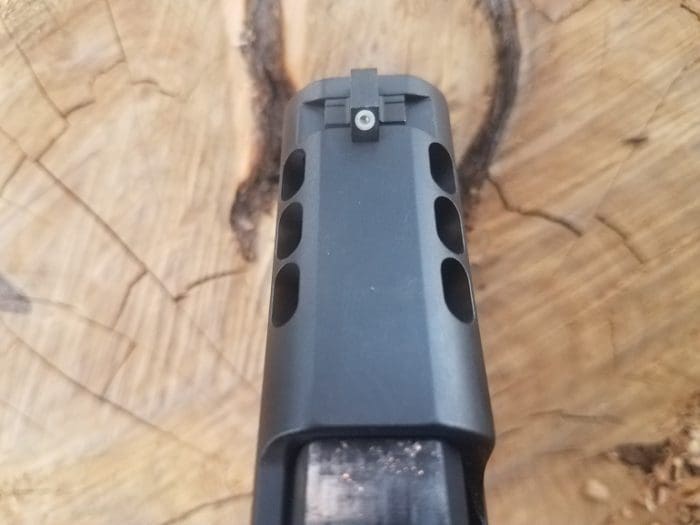
I wouldn’t recommend anyone carry a firearm with a ported barrel for every day carry. There are a couple of big reasons for this.
First, many attacks occur suddenly and in the dark. I’ve proven to myself and others with me while hunting, over and over again, that ported barrels make a big difference in continued visibility at night.
This ported Shield proved the point yet again. One of the great things about The Range At Austin is that you can change the lighting scenarios on the range, including making it so that it is low light at you and the target, and dark everywhere else.
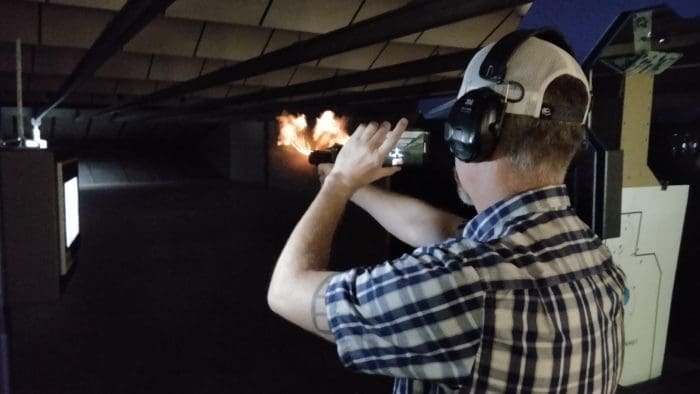
I did just that, and tried to get a few shots of the Performance Center Shield while firing. The first shot was bright due to the muzzle flash, but I could still see my target and sights well enough to make them out for a second shot. But by the third shot, by night vision was blown. I had a to wait a few seconds to be able to see my sights well enough to line them up at all.
Although I didn’t have another Shield to shoot, I did have a Kimber Ultra Covert II with a three-inch barrel. Even though the barrel on the Kimber was actually shorter than the Shield, I could put a full seven-round magazine through it before having trouble discerning the target and the sights. Of course, those are different guns of the same caliber, so it’s no quite apples to apples. But it’s close.
I had two other shooters try the same thing with similar results. It should be noted, however, that the teenage shooter who was with us regained his vision much faster than those of us over 40. Oh, youngsters, enjoy it while it lasts.
The second problem I have with ported barrels is that they force me to think even more. I really suck at thinking in combat. Some people are great at this, and a select few can even think, shoot, move, and communicate all at the same time. Experience has taught me that I have to pick two, and neither of them can include thinking or communicating.
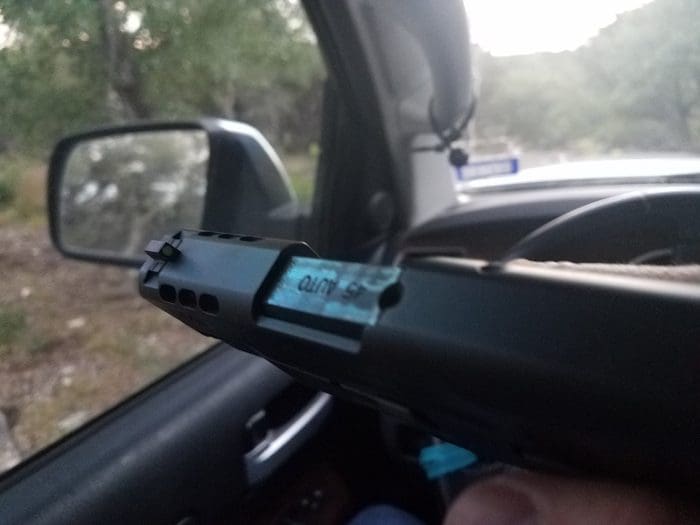
Am I responding to that threat right outside my truck’s window? Do I have to draw and fire across my body, as in a carjacking? I drew the Shield a few times and pointed it rout my window as I would during an assault while seated in the vehicle. The photo above shows where it ended up every time. If I had to fire. that gas would go right into my eyes.
I have a hard enough time making sure I know where my muzzle is. Now I have to know where my muzzle is, and where the top of the gun is to make sure I don’t blow superheated gases into my own face when I pull the trigger.
What if you are carrying a child? That child exponentially increased all the variables, only to increase them yet again once you have to be concerned with the direction of the gas escaping the ports during a defensive gun use. That sounds like a common, but nightmarish scenario.
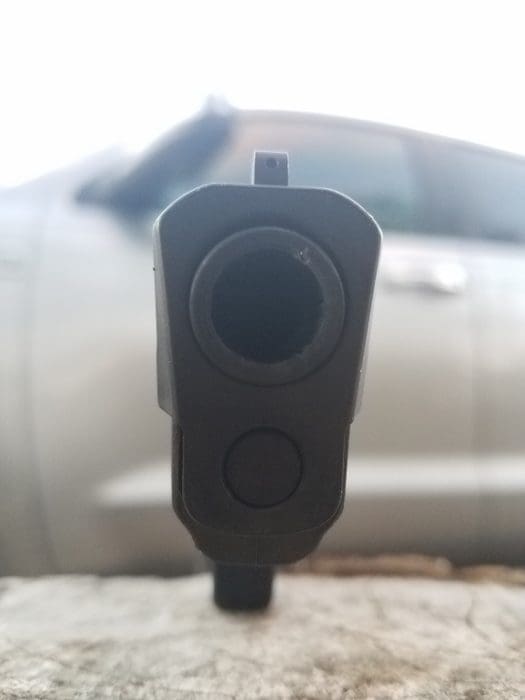
Finally, you just don’t need a ported barrel on a self defense gun. Especially this gun. Just like in my initial Shield review, I was surprised at how little recoil there was in such a small pistol. The great grips and good ergonomics of the Shield help to mitigate what I would have expected to be stout recoil from the .45ACP round. But if recoil is that much of an issue for you, don’t go with the .45ACP version of this gun. The 9mm non-ported Shield is easily accessible, inexpensive, every bit as effective, and all-around just as good an EDC gun.
Given the upgrades included here, S&W is charging a pretty penny. The Performance Center version’s MSRP is $263 more than the standard (M2.0) M&P45 Shield. That number represents the majority of the standard model’s MSRP. Just like the original, the Performance Center version can be found for much less than MSRP at retailers.
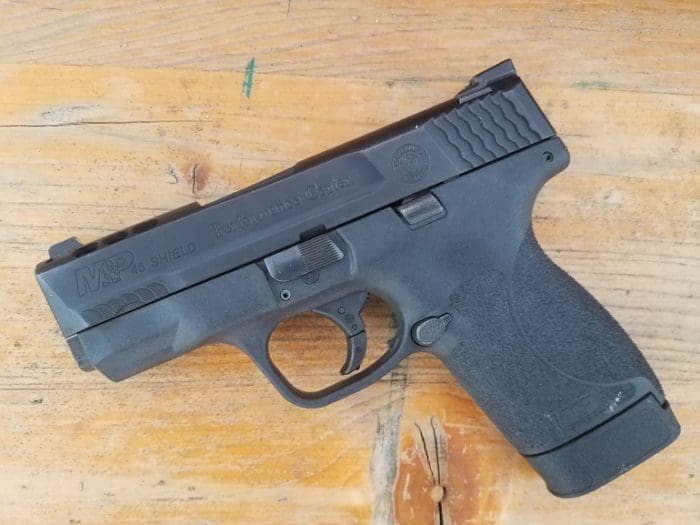
Overall, the Performance Center version of the Smith & Wesson M&P45 Shield is a very good gun. That’s because they took an already great base package and put good sights on it. Unfortunately, the barrel is ported, and the frame is correspondingly cut for the ports. While that’s perfect for some shooters, it isn’t for me.
If you want a ported EDC gun, this is the one for you. If you like everything else about it — and I do — save yourself a couple hundred dollars and go for the M&P 2.0 Shield with tritium sights, and no porting.
Specifications: Smith & Wesson M&P45 Performance Center Shield
Caliber: .45ACP
Capacity: 6+1, 7+1
Barrel Length: 3.3” (8.4 cm)
Overall Length: 6.5″
Front Sight: Tritium Night Sight
Rear Sight: Tritium Night Sight
Action: Semi Auto Striker Fired
Grip: Polymer
Weight: 22.6 oz / 640.7g
Barrel Material: Stainless Steel
Slide Material: Stainless Steel
Frame Material: Polymer
Slide Finish: Armornite®
MSRP: $742
Ratings (out of five stars):
Accuracy * * * *
Three-inch groups or slightly better from a striker-fired EDC compact with a 3.3” barrel is great by any standard.
Reliability * * * * *
Perfection.
Customization * * * *
Smith & Wesson finally has all the options up for this gun most people want. You can get an aftermarket trigger (Apex makes a great one) and now you have sight options as well, right from the factory.
Comfort and Concealability * * * * *
Disappears in an IWB holster.
Overall * * * *
The Performance Center version takes a good gun and makes it ever better. But I’m not a fan of the ported barrel at all. But it’s done well and if that’s your thing, this is a great EDC. If it’s not your thing, the same very good pistol without the ported barrel is available from the factory for considerably less.





The original 45 Shield is on a list of “maybe’s” for me.Almost got one. Amazingly small for a 45. Having shot more I’m now thinking 9mm is just fine for CC. But the S&W 45 is uber cool…so many guns-not enough dough.
Bigger holes is better. Go with the .45 very nice and easy enough to control. Tritium sights are available on standard model.
The ammo is more expensive which translates into less range time. 9×19 is the worlds round for a valid reason. It does the job. Cheaply.
For average joe citizen the 9mm is the best carry round for edc.
And I am a .38 revolver man.
glock 30 already exists
So does this gun. It’s right there in the pictures.
Ive owned and shot both and think the Shield is still a more comfortable shooter. I think the fatness of the G30 along with the slickness of the gen 3 frame doesn’t give it much for controllability, while the M&P M2.0 grip texture is excellent.
M&P trigger and slimness are light years beyond Glocks.
Smith & Wesson the minute the .45 Shield came out, I new I had to have one, I am a California resident so I couldn’t get one, I have 5 9mm’s I said to myself well hang it up, my brother lives in Texas and gave me one for my Birthday, I told the GUN shop it was a gift and DOJ Ok’d it so I have my Shield.45 and Hornady +P 230 grain JHP are doing a fine job, THANK YOU S&W
Smith & Wesson the minute the .45 Shield came out, I new I had to have one, Thank You S&W
Would this work using 45 ACP +P or 45 ACP Super?
There’s a pretty huge difference between the +P and the .45Super. I did fire the Remington Golden Saber +P through this gun without issue. I would not fire the 45 Super through it.
Sorry, follow on dumb question. What gun would you fire using .45 ACP Super (perhaps Buffalo Bore .45 ACP Super)?
I fired it today from a Colt 1911 with a Bar Sto barrel and a heavier spring, and I’ve been shooting a lot of 45 Super through a slightly modified G21. I’ve also shot it through a stock FNX Tactical 45, but you can definatley feel that slide slam back in the frame.
The G1 is the cheapest and easiest gun out there to run 45 super through. I’ve chronoed 230gr rounds going supersonic with it.
Wow. Actual gun content! Sweet! I forget sometime this is a gun related blog.
I really loved the 45 shield. While its slightly bigger than the XDs, its miles more comfortable to shoot, so Ill gladly make that tradeoff. Unfortunately I let mine go because I had a glut of 45’s at the time, Ive been trying to trade back into one but haven’t seen many locally.
When ironicatbest saw the picture he thot,,” An article about a Hi Point” it looks like a Hi Point that took an ugly pill to ironicatbest.
“Some people are great at this, and a select few can even think, shoot, move, and communicate all at the same time. Experience has taught me that I have to pick two, and neither of them can include thinking or communicating.”
Best lines in the article. And exactly why I am restricted to high drag, low speed. Breath, move, & shoot at the same time is about my limit. If want to communicate, I have to stop at least one of those. 🙂
JW, I presume you’ve also tested the Springfield Armory XDs .45 ACP w/3.3″ barrel. How would you compare the .45 S&W Shield to it? Looks like they are very similar. I’ve got an XDs 3.3 and like it – its grip is ergonomically designed so I can have a full range session (about 100 rounds) with it and not feel like my hand was beat up. It’s a good EDC, too. So…I’m curious as to what you think of the comparison.
Well, let me put it this way, I’ve proposed a weekly TTAG segment where all I do is show me pissing on one Springfield Armory product after the next.
It hasn’t been approved. Yet.
I have a standard and a performance center shield. If I am doing IDPA shooting with the performance center I just switch out the barrels.
Do you have a source for a non-ported barrel on a S&W M&P Shield .45 Performance Center? I own one and was thinking of just getting a barrel to swap… or just EDC it’s bigger brother that doesn’t have a ported barrel.
This was my first handgun and I really like it. Since then, I’ve bought a full sized M&P .45 and a 1911. All of these smack an 8.5×11 sheet of paper out to 40 yds and hate the bullseye to 20 yds.
I’ve shot a .357 mag, and .38 special out of a Kimber K6S Revolver. At 10 yds the bullets all land on the paper, but not necessarily the bullseye.
My kid has a Walther PPS in 9mm that is a tighter group, but it’s still scattered compared to my .45s.
I blame the shooter, not the guns. It’s just that my 45s all fit me and recoil consistently for me. Lesson learned: choose the caliber and firearm that fits you.
I was about to buy one as my EDC until u read this article. I had never considered the ported barrel problem, thank you.
Guess I’ll buy a regular one, put an Apex trigger on it and get it milled for an RMR.
Nice review! the gun have awesome features might bought one someday
Try this mags https://amzn.to/38VqIUy
If you love to wear vests? so get this amazing Red Puffer Vest which is a favorite of all girls and it is the most-rated and most selling outfit in our store, shop now because the stock is limited.
Comments are closed.